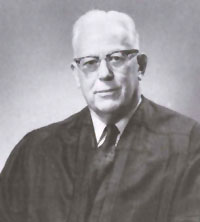

Baker v. Carr et. al., March 2, 1962 (369 US 186)
The case of Baker v. Carr originated in Tennessee. Charles Baker, an elected official
from suburban Shelby County, was first alphabetically in a long list of plaintiffs.
Secretary of State Joe Carr, who served as Tennessee's head of elections, represented the
defendants.
Emerging urban/rural conflicts led to the state's redistricting conflicts. Representatives
from the rural areas of Tennessee dominated the General Assembly, as was also the case
in Washington and many other states at the time. The fast-growing urban population was
asked to pay an increasing tax burden, but without any corresponding changes in numbers
of legislators. The familiar refrain of "no taxation without representation" was as
compelling to Baker and his cohorts as it had been to colonists two hundred years before.
The first hurdle for the plaintiffs was to convince the courts that the issue of
malapportionment of legislative bodies could be considered a federal question subject to
a ruling by the judiciary. Previously, the United States Supreme Court in Colgrove v.
Green (328 US 549) had likened judicial involvement in apportionment to wandering
aimlessly in a "political thicket," and the federal courts had generally refused to consider
redistricting issues. The attorneys for the plaintiffs in Baker v. Carr had no success in the
lower courts, but spent a year preparing an appeal to the Supreme Court. One precedent
in their favor was the ruling in Gamillion v. Lightfoot (364 US 339), which found that
Alabama's district boundaries infringed on the voting rights of its African-American
citizens. The ruling moved questions of apportionment more squarely into the judicial
realm.
Baker's attorneys persuaded the Supreme Court to hear the case and argued that the
Tennessee Legislature was not a viable body to achieve fair apportionment. The
Supreme Court reversed the lower court's ruling in Baker v. Carr on March 26, 1962,
finding that there was a "justiciable constitutional cause of action in which the appellants
are entitled to a trial and decision." Fom this point forward, apportionment was
considered a constitutional issue that fell under the jurisdiction of the courts. The
ramifications for legislative and congressional redistricting were tremendous. Within two
years of the Supreme Court's decision in Baker v. Carr, citizens in forty-one of the fifty
states had filed suit in apportionment cases.
Washington's, was sown in large part by urban-rural conflict. The role of urban-rural
conflict in Baker v. Carr meant that the conflict ultimately influenced how America
votes.
Baker v. Carr provided a profoundly important precedent in that it gave courts a
"justiciable constitutional cause of action in which the appellants [in the case] are entitled
to a trial and decision."
 Earl Warren
Earl Warren
"Next to Brown [v. the Board of Education], the most significant Warren Court case was Baker v. Carr
(1962). The decision there led to a drastic shift in political power throughout the nation . . . the Warren Court
ultimately worked an electoral reform to correct unfair distribution of voters among legislative districts."
The Supreme Court Justices: Illustrated Biographies, p. 439
|

|

